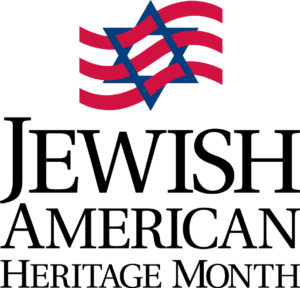 PHILADELPHIA, Pennsylvania (Press Release)—Jewish American Heritage Month (JAHM), a national commemoration of the contributions that Americans Jews have made to the fabric of our nation’s history, culture, and society. The theme for the May 2018 celebration is American Jews and Music, which focuses on the rich and deep influence of American Jews on American music across decades and genres. A newly revamped website, www.jahm.us, offers interactive content and educational resources to facilitate nationwide engagement around this year’s edition. First established by presidential proclamation in 2006 and renewed every year since, JAHM encourages people of all backgrounds to learn about and draw inspiration from the more than 360-year history of Jewish life in this country.
PHILADELPHIA, Pennsylvania (Press Release)—Jewish American Heritage Month (JAHM), a national commemoration of the contributions that Americans Jews have made to the fabric of our nation’s history, culture, and society. The theme for the May 2018 celebration is American Jews and Music, which focuses on the rich and deep influence of American Jews on American music across decades and genres. A newly revamped website, www.jahm.us, offers interactive content and educational resources to facilitate nationwide engagement around this year’s edition. First established by presidential proclamation in 2006 and renewed every year since, JAHM encourages people of all backgrounds to learn about and draw inspiration from the more than 360-year history of Jewish life in this country.
“The stories of American Jews are woven into the rich history of this diverse nation,” says Ivy Barsky, CEO, and Gwen Goodman Director of the National Museum of American Jewish History, the lead sponsor of JAHM. “By celebrating JAHM, we honor the values of inclusion, acceptance, and religious liberty cherished by this country. This year’s focus on American Jews and Music invites deeper exploration of one of the many facets of American life impacted by this community.”
Inspired by the 2018 global Leonard Bernstein centennial celebrations, JAHM’s 2018 theme provides an opportunity to recognize the many American Jews who have helped create the nation’s soundtrack, from patriotic anthems and classical compositions to Broadway scores and rock and roll. There are numerous examples of composers, conductors, lyricists, musicians, and singers who have been shaped by American life, society, and culture, and in turn enriched America’s musical repertoire.
Few understood and leveraged the power of music better than Leonard Bernstein (1918-1990). The accomplished composer, conductor, and humanitarian used music to respond to the social and political crises of his day, whether was breaking racial barriers in his casting decisions for On the Town, or addressing America’s changing ideas about race and ethnicity in West Side Story. Songwriter Irving Berlin (1888-1989) was an Eastern European immigrant who produced timeless hits, including God Bless America, while fighting for the United States in World War I. Singer Fanny Brice (1891-1951), the child of Jewish immigrants, delighted audiences with her vaudeville acts, inspiring a stage and film portrayal by another widely successful singer—global stage and screen sensation Barbra Streisand (b. 1942). Chart-topping hits have been produced by Bob Dylan (b. 1941), Carole King (b. 1942), Paul Simon (b. 1941), Regina Spektor (b. 1980), and many more. The musical output of these creative individuals, among countless others, continues to entertain and inspire today.
“This year’s theme demonstrates, once again, that American Jews have been active participants in the cultural efflorescence of our nation,” shares Dr. Gary P. Zola, Executive Director of The Jacob Rader Marcus Center of the American Jewish Archives and a member of JAHM’s Board of Directors. “America’s national uniqueness derives from the cultural gifts it has imbibed from its remarkably diverse citizenry, and American Jews have always been enthusiastic participants in this endeavor. Today, perhaps more than ever, we should bear in mind the wisdom of Walt Whitman’s powerful observation: America’s greatness is due to its being ‘not merely a nation but a teeming nation of nations,’ and Jewish American Heritage Month is an educational opportunity to reinforce this very important lesson.”
Greg Rosenbaum, President of Palisades Associates, Inc. and chair of JAHM’s Board of Directors, adds, “It is appropriate that we celebrate Jewish American contributions to music in 2018. We can hardly imagine events, from concerts in the local park to baseball games, without the songs created by Jewish Americans. However, it is not just the famous we celebrate this year, but all of those Jewish Americans who assist in making music part of the fabric of our society, whether it be volunteering to help a local orchestra, singing in a barbershop quartet on the Fourth of July, or generating support for the local high school marching band. That is what makes the story of Jewish contributions to music an American story.”
The JAHM website and Fascinating Rhythms resource booklet produced by NMAJH provide myriad ways for individuals and communities around the country to connect to and commemorate JAHM.
- The website delves into the history of American Jewish life through a detailed timeline and map.
- Teachers, students, and lifelong learners can peruse lesson plans and reading lists.
- Fascinating Rhythms includes a list of rich resources such as links to the Milken Archive of Jewish Music and the Library of Congress’ collection.
- Download and share the pdf of the booklet or contact Alyssa Stuble at astuble@nmajh.org to request hard copies.
- For more on individuals such Leonard Bernstein, visit exhibitions like Leonard Bernstein: The Power of Music on view through September 2, 2018 at NMAJH on Historic Independence Mall in Philadelphia and visit the official Bernstein centennial website.
- All are encouraged to submit their JAHM-related events to the calendar, whether it is an exhibition, concert, gallery talk, film screening, lecture, or other program.
- Spotify users can check out specially curated “JAHM On!” playlists featuring Jewish artists and different themes each week.
- Connect to JAHM on social media through Facebook, Instagram, and Twitter and use #JAHM.
*
Preceding provided by the Jewish American Heritage Month organization